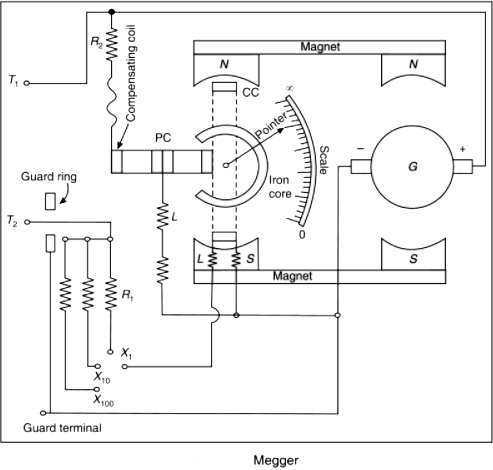Megger works on the principle of _____
Right Answer is:
Electromagnetic induction
SOLUTION
We knew that the resistance of the order of 100 kΩ or above is classified as high resistance. This high resistance is measured by a portable instrument known as Megger.
Principle of Operation
It is based on the principle of electromagnetic induction. When a current-carrying conductor is placed in a uniform magnetic field, it experiences a mechanical force whose magnitude depends upon the strength of current and magnetic fields. The direction of the mechanical force depends on the direction of current and magnetic fields.
Construction of Megger
Basically, Megger consists of d.c. Generator and direct reading ohmmeter as shown in Fig.

The construction of megger is consists of five parts as follows:
(a) The Megger consists of a permanent magnet that provides the fields for both the generator and ohmmeter. The moving element of the ohmmeter consists of three coils.
(i) Deflection coil
(ii) Pressure or control coil
(iii) Compensating coil
These Coils are mounted on a central shaft which is free to rotate over a stationary C-shaped iron core.
(b) The coils are connected to the circuit through flexible leads called ligaments which do not produce a restoring torque on the moving element.
(c) The current coil is connected in series with resistance R1, between one generator terminal and the test terminal T2.
(d) The series resistance R, protects the current coil from the short circuit of the test terminals and it also controls the range of the instrument.
(e) The pressure coil, in series with a compensating coil and protection resistance R, is connected across the generator terminals.
Working
When the current flows from the generator through the pressure coil, the coil tends to set itself at right angles to the field of the permanent magnet.
When the test terminals are open, corresponding to infinite resistance, no current flows through the deflection coil. Thus the pressure coil governs the motion of the moving element making it move to its extreme anticlockwise position. The pointer comes to rest at the infinity end of the scale.
When the test terminals are short-circuited i.e., corresponding to zero resistance, the current from the generator flowing through the current coil is large enough to produce sufficient torque to overcome the counter-clockwise torque of the pressure coil. Due to this, the pointer moves over a scale showing zero resistance.
When the high resistance to be tested is connected between terminals T1, and T2, the opposing torques of the coils balance each other so that pointer attains a stationary position at some intermediate point on the scale. The scale is calibrated in megaohms so that the resistance is directly indicated by the pointer.
The guard ring is provided to eliminate the error due to leakage current. The supply to the meter is usually given by a hand-driven permanent magnet d.c. Generator or sometimes motor-driven generator may also be used.
